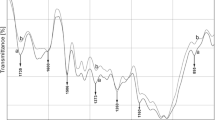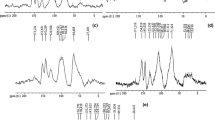Summaries
The appearance of age or the so-called patina of cherry wood and spruce wood was obtained by treatment with ethanolamine vapours. Chemical changes in the treated wood were investigated by FT-IR spectroscopy, electron paramagnetic resonance and nitrogen content analysis. It was shown that the use of aggressive and toxic ammonia could be replaced by fuming with ethanolamine. Extensive colour stability experiments of patinated cherry wood that was coated with linseed oil varnish, linseed oil, beeswax or nitro-cellulose lacquer indicated that the described antiquing method represents a new possibility for producing various wood products with the appearance of age.
Résumé
Le bois de cerisier et d’épicéa a pris un air antique, c’est à dire de la patination, après être traité à la vapeur d’éthanolamine. Des changements physiques dans le bois traité ont été investigués par le moyen de la spectroscopie TF-IR, de la résonance paramagnétique électronique et de l’analyse de la teneur en azote II a été montré que l’emploi de l’ammoniac qui est agressif et toxique pouvait être remplacé par une exposition à la vapeur d’éthanolamine. Des expériences extensives dans le domaine de la stabilité de la couleur du bois de cerisier patiné revêtu d’huile de lin, de vernis à l’huile de lin, de cire d’abeille ou de laque nitro-cellulosique ont indiqué que la méthode décrite de rendre plus antique l’apparence du bois représente une nouvelle possibilité dans le domaine de la production d’objets en bois qui aient l’air antique.
Zusammenfassung
Kirsch- und Fichtenholz wurde durch Behandlung mit Ethanolamingas künstlich gealtert und die chemischen Veränderungen durch FT-IR-Spektroskopie, elektromagnetische Resonanz und Messungen des Stickstoffgehaltes ermittelt. Es zeigte sich, daß man die Verwendung von aggressivem und giftigem Ammoniak durch die Bedampfung mit Ethanolaminen ersetzen kann. Wir führten extensive Tests zur Farbstabilität von künstlich gealtertem Kirschbaumholz durch, das mit Leinöl, Leinöllack. Bienenwachs oder Nitrozelluloselack behandelt worden war. Die Tests zeigten, daß die Behandlung mit Ethanolaminen eine praktikable Methode ist, verschiedene künstlich gealterte Holzprodukte herzustellen.
Similar content being viewed by others
References
Leach N J,Modern Wood Finishing Techniques, 73–127, Stobart Davies Ltd, Hertford UK, 1993
Council Directive 92/32/EEC amending Directive 67/548/EEC ‘On the approximation of the laws, regulations and administrative provisions relating to the classification, packaging and labelling of dangerous substances’,Official Journal,L 154, 1–29, 1992
Commission Directive 2000/6/EC adapting to technical progress Annexes II, III, VI and VII to Council Directive 76/768/EEC ‘On the approximation of the laws of the Member States relating to cosmetic products’,Official Journal,L 56, 42–6, 2000
Convention on the Prohibition of the Development, Production, Stockpiling and Use of Chemical Weapons and on their Destruction (English version), Organisation for the prohibition of chemical weapons, The Hague, 2000
Schmid S, R D Webster and P D Evans,The Use of ESR Spectroscopy to Assess the Photostabilising Effects of Wood Preservatives, The International Research Group on Wood Preservation, Document Number IRG/WP 00-20186, 2000
Brock T, M Groteklaes and P Mischke,European Coatings Handbook, 370–3, Vincentz Verlag, Hannover, 2000
Statgraphics Plus, Standard edition, version 4.0,The Software Package Manual, Manugistics Inc, Rockville USA, 1998
Guidance For The Compilation of Safety Data Sheets For Fertilizer Materials’, Ammonia, Anhydrous’ http://www.efma.org/publications/guidance/section06.asp, July 2003
International chemical safety cards, ‘Ethanolamine ICSC: 0152, http://www.cdc.gov/niosh/ipcs/ipcs0152.html, July 2003
Parameswaran N, Roffael, ‘Kenntnisstand und Untersuchungsergebnisse zur Wirkung von Ammoniak auf Holzspäne’,Holz als Roh- und Werkstoff,42, 327–33, 1984
Pawlak Z and A S Pawlak, ‘A review of infrared spectra from wood and wood components following treatment with liquid ammonia and solvated electrons in liquid ammonia’,Applied Spectroscopy Reviews,32, 349–83, 1997
Humar M and M Petric, ‘Ethanolamine in impregnated wood’,Research Reports: Forest and Wood Science and Technology,61, 143–59, 2000
Humar M and M Petric,Determination of Ethanolamine in Impregnated Wood, The International Research Group on Wood Preservation, Document Number IRG/WP 00-20198, 2000
Tolvaj L and O Faix, ‘Artificial ageing of wood monitored by DRIFT spectroscopy and CIE L*a*b* color measurements’,Holzforschung,49, 397–404, 1995
Ostmeyer J G, T J Elder and J E Winandy, ‘Spectroscopic analysis of southern pine treated with chromated copper arsenate. II. Diffuse reflectance fourier transform infrared spectroscopy (DRIFT)’,Journal of Wood Chemistry and Technology,9, 105–22, 1989
Michell A J, A J Watson and H G Higgins, ‘An infrared spectroscopic study of delignification of eucalyptus regnans’,Tappi,48, 520–32, 1965
Zanuttini M, M Citroni and M J Martinez, ‘Application of diffuse reflectance infrared fourier transform spectroscopy to the quantitative determination of acetyl groups in wood’,Holzforschung,52, 263–7, 1998
Sudiyani Y, S Tsujiyama, Y Imamura, M Takahashi, K Minato and H Kajita, ‘Chemical characteristics of surfaces of hardwood and softwood deteriorated by weathering’,Journal of Wood Science,45, 348–53, 1999
Zhang J and D P Kamdem, ‘FTIR characterization of copper ethanolamine — wood interaction for wood preservation’,Holzforschung,54, 119–22, 2000.
Craciun R and P D Kamdem, ‘XPS and FTIR applied to the study of waterborne copper naphthenate wood preservatives’,Holzforschung,51, 207–13, 1997
Yalinkilic M K, Y Imamura, M Takahashi, R Ilhan, A C Yalinkilic and Z Demirci, ‘FTIR studies of the effects of outdoor exposure on varnish — coated wood pretreated with CCB or water repellents’,Journal of Coatings Technology,71, 103–12, 1999
Bentley J and G P A Turner,Introduction to Paint Chemistry and Principles of Paint Technology, (4th edition), Chapman & Hall, London, 1998
Hon D N S and S T Chang, ‘Surface degradation of wood by UV light’, Journal of Polymer Science,Polymer Chemistry Edition,22, 2227–41, 1984
David N and S Hon, ‘Photochemistry of wood’,Wood and Cellulosic Chemistry, 525–57, (ed) D N S Hon and N Shiraishi, Marcel Dekker, New York, Basel, 1991
Grelier S, A Castellan and D P Kamdem, ‘Photoprotection of copper-amine-treated pine’,Wood and Fiber Science,32, 196–202, 2000
Rowell R M,The Chemistry of Solid Wood.Advances in Chemistry Series No207, 614, American Chemical Society, Washington DC, 1984
Author information
Authors and Affiliations
Corresponding author
Rights and permissions
About this article
Cite this article
Petric, M., Kricej, B., Humar, M. et al. Patination of cherry wood and spruce wood with ethanolamine and surface finishes. Surface Coatings International Part B: Coatings Transactions 87, 195–201 (2004). https://doi.org/10.1007/BF02699635
Published:
Issue Date:
DOI: https://doi.org/10.1007/BF02699635




